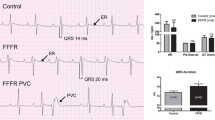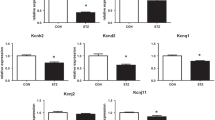Abstract.
Experimental study of cardiac function in the diabetic heart has focussed mostly on models of Type I diabetes. We studied cardiac function in the Goto-Kakizaki (GK) rat, an inbred model of spontaneous non-obese, Type II diabetes.
Methods:
Both isolated perfused hearts and isolated ventricular myocytes from GK and matched control Wistar rat hearts were studied. Percent myocyte twitch shortening (%TS) and corresponding intracellular calcium transients (indo-1 fluorescence ratio, R) were measured over a range of stimulation frequencies (0.5–2.5 Hz; 32 °C, n = 16–24 cells). In isolated Langendorff-perfused hearts, we measured systolic LV pressure (LVPmax), left ventricular end diastolic pressure (LVEDP), maximal rate of LV pressure rise (LV dP/dtmax) and fall (LV dP/dtmin) and isovolumic LV relaxation (exponential time constant, T) both at baseline and during brief (10 minutes) hypoxia.
Results:
The %TS and corresponding indo-1 R were similar between GK and control myocytes at all stimulation frequencies (e.g. at 2.5 Hz: % TS = 8.6 ± 0.77 and 8.2 ± 0.19; R = 0.19 ± 0.009 and 0.18 ± 0.018, GK and control respectively, P = NS). Similarly, there were no significant differences in baseline LVPmax (129 ± 6.2 and 135 ± 9.6 mmHg; GK and control respectively, P = NS), LV dP/dtmax (3169.5 ± 165.80 and 3390.6 ± 232.60 mmHg/s; GK and control respectively, P = NS), LV dP/dtmin or T (24 ± 0.7 and 25 ± 0.6 ms, GK and control respectively, P = NS). During 10 min hypoxia, LV dP/dtmax decreased significantly more, and LVEDP and T increased signifi- cantly more, in GK compared to control hearts (LV dP/dtmax: 668.90 ± 32.8 versus 1027.10 ± 84.0 mmHg/s; LVEDP: 21.4 ± 4.3 versus 11.6 ± 0.6 mmHg; T: 102 ± 13.8 versus 56 ± 3.0 ms; GK versus control respectively; all P < 0.05). These abnormalities in GK hearts were reversed with acute addition of insulin (0.01 i. u./ml) to the perfusion buffer.
Conclusion:
The GK model of Type II diabetes displays a mild cardiomyopathy evident as exaggerated diastolic dysfunction during hypoxia. The mechanism is likely to involve substrate deficiency.
Similar content being viewed by others
Author information
Authors and Affiliations
Corresponding author
Rights and permissions
About this article
Cite this article
El-Omar, M.M., Yang, ZK., Phillips, A.O. et al. Cardiac dysfunction in the Goto-Kakizaki rat. Basic Res Cardiol 99, 133–141 (2004). https://doi.org/10.1007/s00395-004-0440-4
Received:
Revised:
Accepted:
Published:
Issue Date:
DOI: https://doi.org/10.1007/s00395-004-0440-4




